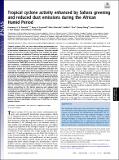Tropical cyclone activity enhanced by Sahara greening and reduced dust emissions during the African Humid Period
Author(s)
Pausata, Francesco S. R.; Chiacchio, Marc; Diro, Gulilat T.; Sushama, Laxmi; Stager, J. Curt; Donnelly, Jeffrey P.; Emanuel, Kerry Andrew; Zhang, Qiong, S.M. Massachusetts Institute of Technology; ... Show more Show less
Download6221.full.pdf (1.595Mb)
PUBLISHER_POLICY
Publisher Policy
Article is made available in accordance with the publisher's policy and may be subject to US copyright law. Please refer to the publisher's site for terms of use.
Terms of use
Metadata
Show full item recordAbstract
Tropical cyclones (TCs) can have devastating socioeconomic impacts. Understanding the nature and causes of their variability is of paramount importance for society. However, historical records of TCs are too short to fully characterize such changes and paleo-sediment archives of Holocene TC activity are temporally and geographically sparse. Thus, it is of interest to apply physical modeling to understanding TC variability under different climate conditions. Here we investigate global TC activity during a warm climate state (mid-Holocene, 6,000 yBP) characterized by increased boreal summer insolation, a vegetated Sahara, and reduced dust emissions. We analyze a set of sensitivity experiments in which not only solar insolation changes are varied but also vegetation and dust concentrations. Our results show that the greening of the Sahara and reduced dust loadings lead to more favorable conditions for tropical cyclone development compared with the orbital forcing alone. In particular, the strengthening of the West African Monsoon induced by the Sahara greening triggers a change in atmospheric circulation that affects the entire tropics. Furthermore, whereas previous studies suggest lower TC activity despite stronger summer insolation and warmer sea surface temperature in the Northern Hemisphere, accounting for the Sahara greening and reduced dust concentrations leads instead to an increase of TC activity in both hemispheres, particularly over the Caribbean basin and East Coast of North America. Our study highlights the importance of regional changes in land cover and dust concentrations in affecting the potential intensity and genesis of past TCs and suggests that both factors may have appreciable influence on TC activity in a future warmer climate.
Date issued
2017-05Department
Massachusetts Institute of Technology. Department of Earth, Atmospheric, and Planetary SciencesJournal
Proceedings of the National Academy of Sciences
Publisher
National Academy of Sciences (U.S.)
Citation
Pausata, Francesco S. R. et al. “Tropical Cyclone Activity Enhanced by Sahara Greening and Reduced Dust Emissions During the African Humid Period.” Proceedings of the National Academy of Sciences 114, 24 (May 2017): 6221–6226 © 2017 The Authors
Version: Final published version
ISSN
0027-8424
1091-6490